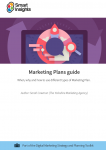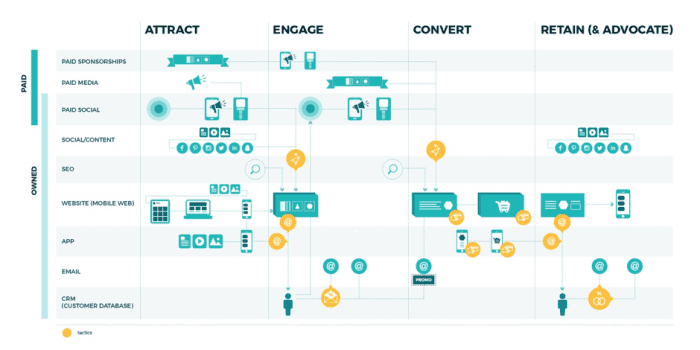Cohesive customer journeys rely on brand and growth marketers working together
Many modern-day marketing departments are now split into two distinct groups: brand marketers who are tasked with building consumer awareness and growth or channel marketers who are tasked with transforming that awareness into action. Although both parties play for the same team, they often possess different internal priorities. It is easy for silos to emerge that make collaboration an uphill battle.
There is overlap between what brand marketers and growth marketers provide. They each play pivotal roles in fueling department-wide success — but only if they work in tandem to create cohesive customer journeys.
Cohesion matters
It is incredibly important for brand and growth marketers to be in sync and aligned with a core KPI. Otherwise, it is nearly impossible to create a consistent experience that guides consumers from awareness to conversion to life-long advocacy.
Modern-day consumers will no longer tolerate irrelevant, inconsistent marketing campaigns — and if Marketing Week’s 2017 study is any indication, brands are struggling to keep up with the times.
So what does an inconsistent customer experience look like, and why does this happen so often? Here’s just one example:
Brand teams rarely own the homepage, but this is where they often aim to drive consumers. Through strategic design and offers, their TV commercials and paid social ads could pique a certain demographic’s interest, but when these potential consumers visit the brand’s website to learn more, they’ll enter a completely different environment that does not match what they previously saw. Everything looks and feels different, and the offer they were interested in is nowhere to be found. They feel frustrated, and they navigate elsewhere.
Some customers are unnecessarily lost due to a disconnected customer experience.
At the end of the day, brand marketers and growth marketers need to ensure every touchpoint along a customer’s journey projects consistent messaging, benefits, offers, copy, and colors. Otherwise, the audience will quickly lose interest and seek an alternative option.
To continue the previous example, many marketers who can’t change the homepage create landing pages — one for every target audience, campaign, or promotion. Oftentimes, there isn’t enough traffic to gain statistically significant insights on a single landing page, and there isn’t a strategy to consistently design and develop pages to capture insights across multiple pages because of team structure.
There are several ways to boost collaboration and cohesion across these two groups, but in my experience, building a campaign map can prove to be the most helpful.
Mapping your customer journey
Campaign mapping is just as it sounds: You create a visual representation of the entire campaign and map out every possible customer experience. The goal is to connect the dots across all touchpoints, show all parties how their efforts feed into the big picture, and ultimately drive customer actions to a single business goal.
A great campaign map will feature a high-level view of everything going on in a campaign. It should include every acquisition channel that is in play: TV and radio spots, paid display, paid social, and any other piece of content. Most importantly, it should also show where each channel intends to drive the customer.
If, for example, your creative team sits down to design and develop an asset, the campaign map should show where the customer is coming from and where he or she will go next. It should provide much-needed context and increase the likelihood that this asset will fit perfectly with all other assets along the buyer’s journey.
So how exactly do you go about creating a campaign map? The following four steps will point you in the right direction:
1. Identify your entry points
Think through the customer’s journey, and pinpoint where each marketing initiative drives him or her.For example, does your TV spot lead consumers to type your URL into the search bar, or will they feel compelled to Google your brand? If they Google you, which landing page will pop up first? Do the same exact exercise with your paid social placements, acquisition emails, and any other outreach you conduct. This is a key first step to crafting a great campaign map.
Be wary of which campaigns drive traffic to your homepage, as this isn’t always an ideal destination for consumers. For example, people coming from a podcast will likely have already received a sales pitch from a trustworthy source (the host). They will have a strong understanding of your product and have higher intent to sign up or purchase right away. The main website needs a clear and easy path for someone who is ready to purchase to take the next step.
Someone coming from a banner ad, on the other hand, probably knows very little about your brand and the benefits you provide. But as a marketer, you know a little bit about them (demographics, for example). You also know what information they already saw in the banner ad. A landing page that continues the story would be a solid entry point for these individuals, as it allows them to gain a deeper understanding of who you are and how your product or service works.
2. Forge a path to lifetime value
Most campaign maps end after step one, but they need to go further. It is crucial to keep thinking through the rest of the flow. Ask yourself, “What are the core actions I want consumers to take after they find my brand?” and “Where do I want them to go from the landing page or homepage?”Some common options include downloading your app, signing up for a free trial, or subscribing to your newsletter. In the case of music streaming services, for example, the ideal next steps would be for someone to sign up, launch the platform, and begin listening.
It’s easy to go a bit overboard during this step, but your end goal is to capture the remaining steps consumers need to take toward first-time use.
3. Identify where customers might drop off (and how to bring them back)
In a perfect marketing world, teams would be tracking engagement from each individual entry point all the way through to the point of initial product usage — or even further, if possible. But customer journeys aren’t linear. Most people drop out of a cart experience. So how do you bring them back?The first place we start is with barriers. What are all the reasons why someone could have dropped off that we can address? Are people worried about the price? Or are they concerned about compatibility? Quality? Can we retarget drop-offs with content or banner ads? Can we use customer or industry testimonials to bring them back? Start with the content that might bring a potential customer back. Then, consider what information you have to target someone? Retargeted paid social display content, email, and even direct mail can be used to test what drives someone back to convert.
4. Incorporate key benchmarks and metrics
Using your map as a single place where all key benchmarks and metrics live will turn it into an essential tool for your entire marketing department. As each party pursues its priorities, it can have the other one’s goals in mind.But this isn’t just about establishing benchmarks; it is also about optimizing future efforts toward what’s already working. When a marketing team has limited dollars to make a certain impact, it can double down on the channels that work.
For example, if the marketing team sees that one target audience is performing better than others and needs to hit its end-of-year sales goals, it can create a campaign that is especially targeted for that segment or channel. If one particular email in a win-back series performed the highest, what was the message, content, or offer that could be applied to acquisition.
Everyone in your marketing department should be focused on the same goals: gaining new customers and growing the business. It only makes sense to create a map — a campaign map, at that — that keeps everyone connected and moving in the same direction.



